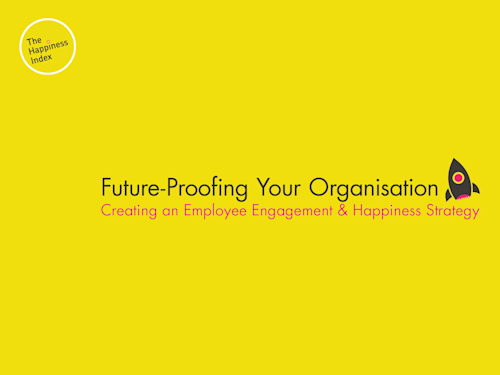
Creating an Employee Engagement AND Happiness Strategy
Wellbeing is a key pillar of many HR team’s remit. Supporting your team’s physical and mental wellbeing is an important role that often gets overlooked. Find out all you need to know about running an employee wellbeing survey that helps you to achieve your organisation’s goals.
Employee wellbeing can mean different things to different people in different situations. For us employee wellbeing includes supporting both mental and physical health, both within and outside of the workplace as the two can and will interact.
Sometimes wellbeing can be seen as a nice-to-have but the truth is that a focus on wellbeing is an imperative for organisations who want to perform as well as they can. Did you know that the word wellbeing shares the same root as wealth, and comes from the same Anglo-Saxon origin? These ancient people knew what they were talking about as wealth and wellbeing are still tied together, and organisations would do well not to ignore the links.
It’s really important to gather both qualitative and quantitative data when trying to measure employee wellbeing. That’s why we recommend employee wellbeing surveys to gain a greater understanding of your employee wellbeing.
At THI we use a mix of questions answered on a 10 point scale and with open text. This allows the collection of quantitative data which can be benchmarked and improved. And it allows the collection of qualitative data to provide context, depth and actionable ideas. Both in tandem is the best way to measure employee wellbeing.
Employee wellbeing surveys allow organisations to understand and measure how their employees feel about their own wellbeing. A good employee wellbeing survey should include questions about your team’s mental and physical health to allow you to gather holistic data. This allows for a full and thorough understanding of the support your people need in order to thrive.
In order to be successful an employee wellbeing survey should be:
Completely anonymous - you won’t be able to gain accurate data if your people don’t feel they can answer candidly
Carefully constructed - your team needs to feel that the questions asked are addressing their actual needs
Action oriented - you need to be able to take action off the back of any question you pose so that anyone answering the survey doesn’t feel like it is a box-ticking exercise
Repeatable and repeated - you will need more than one data point to really understand your people’s wellbeing
Data gathered through employee wellness surveys should be used to support your employee wellbeing programme. As with many aspects of HR there isn’t a one-size-fits-all approach to employee wellbeing. This is what makes employee wellbeing surveys a key part of any organisation’s strategy. You need to understand your people’s unique needs and wishes.
Not only should your wellness strategy be targeted to the individuals within your organisation, but listening to your team can actually support employee wellbeing in its own right. Acknowledgement plays a key part in employee happiness and feelings of wellbeing. By listening to your team you will help feel listened to and give them an opportunity to provide feedback.
There are a couple of key types of employee wellness surveys. We recommend running as many of these as you have resources to support.
A good wellbeing survey looks at both mental and physical wellbeing. In many workplaces the physical impacts of the office can be overlooked, but even in offices where most individuals have desk-bound roles, physical health can be impacted and will also affect the working environment. This kind of survey is actually more important in a workplace where health and safety aren’t as fore-fronted as they are in more physical jobs. Find Out More About Our Wellbeing Survey >
Mental health can have a big impact in the workplace. We always recommend thinking about workload and stress levels as part of your wellbeing survey to understand how your workplace in particular is impacting your employees. Having a stand alone mental health survey allows you to really unpack the impact this area of wellbeing is having on your people, but also reveal how to support your people best. Find Out More About Our Mental Health Survey >
Having a 24/7 listening solution can be massively impactful when it comes to employee wellbeing. This is because employee wellbeing doesn’t neatly fall into survey time-frames, but situations can develop at any time. Having an always-on survey allows you to be much more responsive to your people’s wellbeing needs. Especially if you have a feature such as our ‘closing the feedback loop’ tool available to protect anonymity. Find Out More About Our Employee Voice Survey >
We always recommend asking questions that link to all four brain systems, this will give you a holistic view of your people’s mental and physical wellbeing. Plus, you’ll be able to see how your people think and feel about your wellbeing offering.
When thinking about the instinctive brain system, questions which centre on mental and physical safety as well as freedom, are key. The safety questions will provide the backbone of your survey, as compromised safety both physical and mental can have an adverse effect on your team’s wellbeing. Freedom is also important for your team’s mental wellbeing, because when people don’t feel free to be themselves or support themselves freely they will struggle with their wellbeing.
The key neuroscience theme within the emotional brain system is relationships. Positive relationships with both colleagues and leadership are so key when it comes to wellbeing within the workplace. Understanding how your team feel about these relationships should be one of the key aims from your wellbeing survey.
Including rational questions within a wellbeing survey might seem unintuitive, but the truth is that no one is well all of the time, physically or mentally. It’s really important as an employer that you know that your people understand what support is available when they’re not doing well, and that they feel supported during these times.
Your organisation’s values and commitment to your employees will impact their feelings of wellbeing at work. Not all wellbeing surveys will include questions around this brain type, but including a values survey within your listening programme can help to support your understanding here.
Alongside specific questions you should also give your team space to expand on their scores. This will help you to gather vital context to the answers. Of course, having good reporting capabilities will be important in order to parse any feedback into actionable insights.
Employee wellbeing surveys can have a much more wide-ranging and deeper impact than many people think. Understanding the importance of wellbeing is just the beginning. Here are some of the impacts you can expect from investing in your team’s employee wellbeing:
Decrease presenteeism
Increase productivity
Reduce risk of injury or illness
Lower incidence of burnout
Improve retention of key talent
Support work-life balance
A well designed employee wellbeing survey will help you to understand what your people need and want in order to support their wellbeing, both mental and physical. As long as your survey is well designed, it should provide actionable insights which can feed directly into your HR strategy.
Things you may discover include:
Successes to celebrate - our customers often find that there are areas of their current wellbeing programme that are resonating well with their people. This can be very useful feedback, particularly in recruitment efforts.
Communication gaps - wellbeing surveys can reveal that your team isn't aware of benefits or support that you already offer. This feedback results in an easy fix, as communication around these areas can be increased or improved.
Quick wins - customers often uncover quick wins through their surveys. There are often areas where there is an obvious support that can be offered, such as additional training for managers, improved communications, or specific departments where learnings can be applied from other teams.
Gaps in your offering - it’s possible that your survey uncovers an important gap in your offering. By completing a survey and discovering this before it becomes a big problem, you can avoid escalation.
Areas to dig deeper - one survey isn’t going to solve all your wellbeing problems, but customers always find a nugget that leads to further exploration. This may come in the form of a further survey, a focus group, or perhaps one-on-one conversations. Our Closing The Feedback Loop tool can facilitate the latter while maintaining anonymity.
There are some key ways in which our platform can enable you to run an employee wellbeing survey that enables you to achieve your organisation’s goals.
There’s no point investing time and resources in a wellbeing survey if you’re unable to take action, as this can seriously erode trust with your people. That’s why our mental health and wellbeing surveys are designed by experts to give you actionable insights - uncover areas to improve and build your programming.
Every question in all our pre-built employee surveys are linked to our neuroscience-backed methodology, which allows you to review the results you get within the wider context of your other feedback. This means you will gain a wider and deeper understanding of how your employee’s engagement and happiness feeds into their wellbeing across their employee lifecycle.
Being able to understand the implications of the feedback you get from your wellbeing survey will be key in implementing a successful action plan. Without this you won’t be able to achieve the goals your organisation has targeted. Our reporting allows you not only to get a quick top-level overview, but also helps you dig deeper into the data to get valuable insights.
Wellbeing, and mental wellbeing in particular, is a very personal topic. In fact, a recent CIPD study showed that most employees don’t speak to their boss or employer about health issues. Similarly half of respondents felt they weren’t encouraged to speak about their mental health at work. This means that guaranteeing anonymity is really important, as it will allow you to gain a true understanding of your team’s wellbeing.

Linked to Happiness & Engagement in our neuroscience methodology... learn more
The Happiness Index helps organisations measure the key employee engagement AND happiness drivers to power their people strategy.
Our unique platform offers the products, insights and tools to shine a light on your cultural health and empower management to drive thriving cultures.
Our neuroscience-based pre-built surveys measure the full employee experience - from onboarding to exit to empower and enable organisations to understand their people and create data-led action plans.
